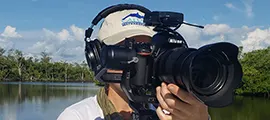State Would be First to Set Water-quality Standards for Cyanotoxins
Today’s petition requires the department to consider adopting pollution limits for algae cyanotoxins, which are linked to liver disease and neurodegenerative risks in people. The state could be the first to establish water-quality criteria to protect swimmers, boaters and fishermen from recreational exposure to the dangerous cyanotoxins.
“These standards are crucial to protecting Florida’s people and wildlife from toxic algae,” said Jason Totoiu, a senior attorney at the Center. “As someone who grew up wade-fishing the Indian River Lagoon, I know it’s critical for the state to address this dangerous, disgusting problem. Rising temperatures and changing rainfall patterns driven by climate change will worsen this risk in the years ahead. Our communities have suffered more than a decade of government inaction. We deserve better.”
The petition asks the Florida Department of Environmental Protection to adopt the recommended criteria published by the EPA in 2016, which are far more protective than the final recommended criteria issued by the agency this week.
Florida’s lakes, rivers, springs and estuaries have some of the nation’s worst algae blooms. They cost local economies hundreds of millions of dollars. The blooms stem from nutrient pollution from domestic, industrial and agricultural wastes, as well as climate change and short-sighted water-management decisions. The U.S. Army Corps of Engineers routinely discharges algae-laden water from Lake Okeechobee into the Caloosahatchee and St. Lucie rivers and estuaries.
The algae produce cyanotoxins, which threaten human health and wildlife. People exposed to cyanotoxins through drinking polluted water, contacting algae through the skin or inhalation may experience health consequences, including higher liver-disease risk. There is also growing concern that people and marine mammals exposed to waterborne B-methylamino-L-alanine, derived from cyanotoxins, may have an increased risk of neurodegenerative diseases.
“Sanibel and Captiva islands are beautiful, special places that face a major threat from harmful algal blooms,” said Ryan Orgera of the Sanibel-Captiva Conservation Foundation. “Our way of life is at stake, and our health and wildlife hang in the balance. We need our state to create and enforce commonsense water-quality standards that will protect us and our children and grandchildren.”
“The public health risks from cyanaobacteria blooms are well recognized and appear to be the basis for our state governors repeatedly issuing a state of emergency when large blooms occur,” said John Cassani of Calusa Waterkeeper. “Yet Florida has no ‘actionable’ criteria adopted for evaluation of the environmental effects or public health risks from cyanotoxins.”
The standards are designed to help the department monitor water quality and identify and clean up waters impaired by cyanotoxins. They would also assist state officials in notifying the public of the health risks of swimming, wading or boating in waters with high cyanotoxin levels.
Criteria would also help optimize watershed planning, protection and restoration in watersheds like Lake Okeechobee and the Caloosahatchee and St. Lucie estuaries by establishing specific performance measures tied to protecting human health through recreational exposure and for fish, wildlife and the aquatic environment.
The EPA recommendations released this week to protect human health and water quality from dangerous cyanotoxins allow 8 micrograms per liter for microcystins and 15 micrograms per liter for cylindrospermopsin.
Those levels are much less protective than those proposed by the EPA in 2016, which were 4 micrograms per liter for microcystins and 8 micrograms per liter for cylindrospermopsin.
Review Full Petition

























